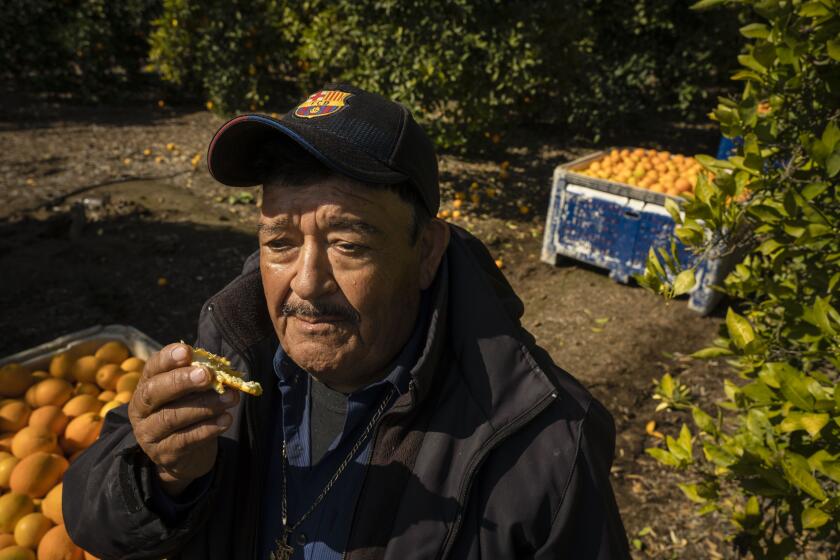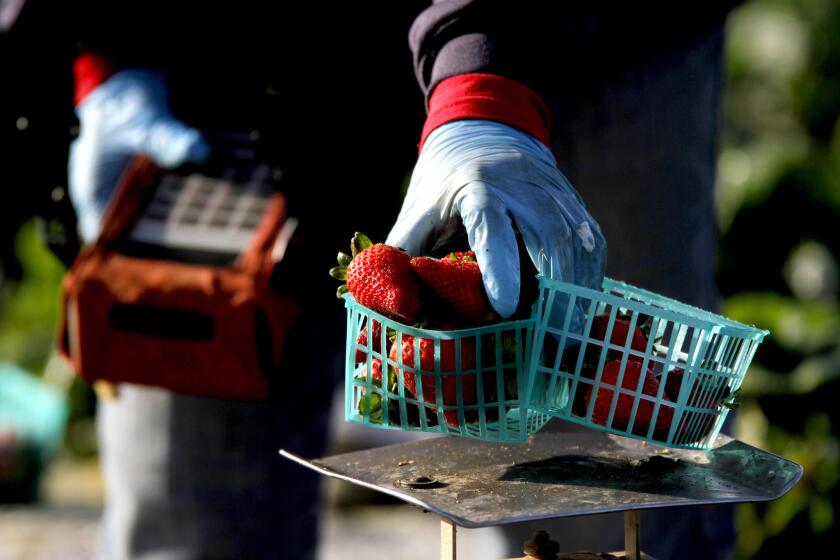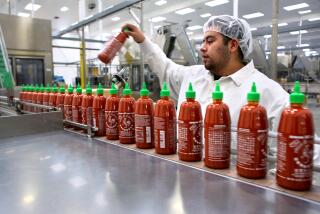From caviar to apple juice, coronavirus is changing the way the world feeds itself
- Share via
SINGAPORE — In the dozen years since Lucas Papierniak first scouted Bali, Indonesia, for its tuna fishing, the seafood supplier has built a thriving business shipping poke cubes to hundreds of restaurants and sashimi-grade yellowfin to high-end sushi bars in Los Angeles and New York.
But almost immediately after lockdowns were announced last month to slow the spread of the coronavirus, orders for his fish came to a stop. One East Coast customer canceled a purchase of two 45,000-pound containers of poke cubes valued at about half a million dollars.
“Business just died,” said Papierniak, whose company is based in Hawaii. “We had to figure out how to keep paying our fishermen.”
The 40-year-old father of four, including a newborn, started scrambling for ways to keep 5,000 fishermen and 350 factory workers on his payroll. His distributor in downtown Los Angeles suggested tapping into the extraordinarily busy grocery industry by supplying tuna steaks. The change in business keeps him open, but each day is a struggle; tuna steaks command a fraction of the price of sashimi.
Even if restaurants were to reopen in the near future, Papierniak estimates it would take three months to restart his supply chain.
“This isn’t going to blow over once shelter-in-place is lifted,” he said.
The coronavirus pandemic is short-circuiting the intricate network of producers and suppliers like Papierniak needed to power the global food system. It affects everything from caviar to apple juice and from Michelin-grade restaurants to the shopkeeper selling nuts and canned goods in a village in India.
Restaurants, an industry where Americans devote more than half their annual food budget, are out of action. Cargo freight and ports are operating well below normal capacity. And the labor that propels the harvesting, packing and delivery of food can’t return to full force until conditions are safe.
California’s 420,000 farmworkers are working through the crisis. But language barriers and a lack of communication on the coronavirus put many at risk.
The crisis has upset the palates of consumers in richer countries who are accustomed to eating whatever and whenever they want thanks to synchronized, rapidly moving economic designs that can make all manner of food appear, including out-of-season blueberries from the Southern Hemisphere.
“The system has evolved to be highly efficient; able to get food from Asia or South America onto the grocery store shelves within days,” said Joseph Glauber, a senior research fellow at the International Food Policy Research Institute and the former chief economist at the U.S. Department of Agriculture. “Now we have all these things gone from stores in the U.S. I lived in Mali for two years in the ’70s and the grocery stores were always that way. It’s striking if nothing else.”
Glauber said supermarkets weren’t designed to suddenly absorb all the spending on food that normally takes place at restaurants. Whether the scenes of sparsely stocked shelves worsens into a genuine food shortage will depend on the length of the pandemic and whether nations can refrain from protectionism, he added.
Already Vietnam, the world’s third-largest exporter of rice, suspended sales to foreign buyers. Kazakhstan banned exports of flour. And the Russian-led Eurasian Economic Union, which also includes Belarus, Armenia and Kyrgyzstan, halted exports of rye, soybeans, and some flour.
Glauber said the bans were mostly symbolic, to ease concerns about shortages at home. Global grain stocks, he added, were high enough to weather a months-long disruption.
That doesn’t mean other food sectors aren’t feeling the pain. The virus, as it has done in the lives and neighborhoods it has swept through, has forced new reckonings.
Dairy farmers in the U.S. and Canada are reportedly dumping millions of gallons of milk because they can no longer supply schools and restaurants.
The supply of apple juice to the U.S. is in jeopardy because of delays at Chinese ports, according to Mintec, a commodities research firm that estimates two-thirds of the kid-friendly beverage consumed by Americans originates from China.
California almond growers are struggling to get their product into their top export market, India. Ports there are in disarray, prompting some to declare force majeure, as strict lockdown measures have left many migrant workers at home.
California’s nearly $50-billion agricultural industry is bracing for a potential labor shortfall that could hinder efforts to maintain the nation’s fresh food supply amid the widening coronavirus outbreak.
“It’s difficult to see how the national and state governments [in India] are going to get the machine going again,” said Richard Waycott, president and chief executive of the Almond Board of California. “A lot of merchandise is still on the water.”
A prolonged interruption in shipments could be costly for the $5.5-billion California almond industry. Exports account for more than two-thirds of the almonds shipped by the state last year.
Pork belly prices have tumbled to their lowest in more than two decades now that supermarkets are one of the only places producers can offload bacon.
The U.S. pork industry had been primed to rake in more export sales. A swine flu that killed more than 40% of China’s hog population helped fuel a record $7 billion in U.S. pork exports last year to fill demand.
Farmers aren’t able to calibrate their herds to adjust for changes in foreign demand or, as in today’s case, the near absence of the restaurant industry. Starting with breeding, it can take up to 18 months to prepare a herd for market.
“Biology prevents producers from instantly responding to price changes,” said Lee Schulz, a livestock economist at Iowa State University. “We don’t have the ability to slow down production.”
Processing plants designed to serve restaurants and other food service businesses also aren’t all equipped to prepare and package pork for grocery aisles, which require smaller portions and often different cuts.
In another sign of how the outbreak has disrupted the food business, once-unpopular items are now back in vogue.
Demand for beans is skyrocketing because their long shelf life is coveted during times of uncertainty. Goya Foods Inc., the New Jersey brand synonymous with canned beans, reported demand quadrupling at grocery stores.
Demand for vitamin C pushed the price of frozen orange juice concentrate in commodities markets up 25% in late February — this after the beverage faced years of decline in the face of growing competition and declining interest in traditional breakfasts.
Even canned tuna has made a big comeback. Thai Union Group, owner of Chicken of the Sea, saw a 25% surge in share value on the Thai Stock Exchange in mid-March as cans of its signature product were scooped up by shoppers.
More to Read
Sign up for Essential California
The most important California stories and recommendations in your inbox every morning.
You may occasionally receive promotional content from the Los Angeles Times.














